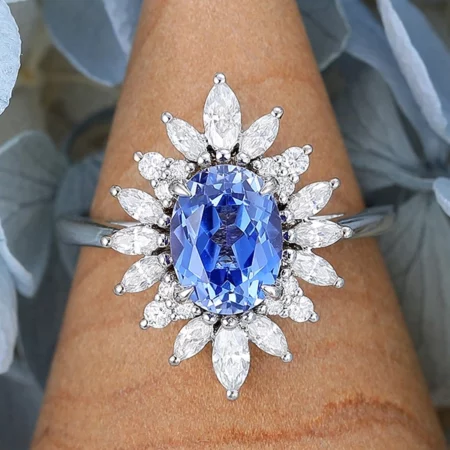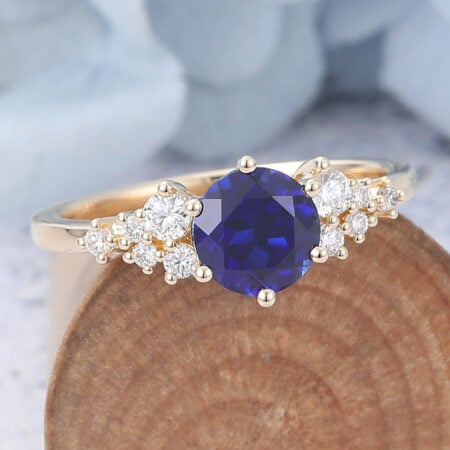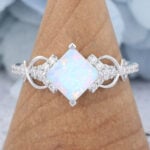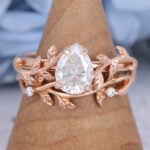Sapphire Engagement Rings: How to Choose the Perfect One
Sapphire engagement rings have become a popular alternative to traditional diamond rings. Their rich colors, durability, and historical significance make them a meaningful choice for couples seeking something unique. If you’re considering a sapphire engagement ring, it’s essential to understand how to select the perfect one. This guide covers the key factors, from color and clarity to settings and personal style, helping you make an informed choice.
Understanding Sapphire Engagement Rings
Sapphire engagement rings are prized for their beauty and strength. Sapphires belong to the corundum family, making them one of the hardest gemstones, second only to diamonds. This makes them highly suitable for everyday wear. Traditionally, blue is the most popular sapphire color, but sapphires also come in pink, yellow, green, and even color-changing varieties. Knowing the characteristics of different sapphires will help you choose a ring that lasts and looks stunning.
Color: The Heart of Sapphire Engagement Rings
When selecting a sapphire engagement ring, color is the most crucial factor. The ideal sapphire color is deep, vivid, and evenly distributed across the stone. While lighter shades may appear delicate, they tend to be less valuable. Darker tones can look elegant but may appear almost black in certain lighting. Consider your partner’s skin tone and personal preference. For example, classic blue sapphires suit most skin tones, while pink or yellow sapphires can create a more unique, personalized look.
Clarity and Cut
Clarity refers to the presence of inclusions, or internal imperfections, in a sapphire. While some inclusions are natural and do not impact durability, excessive flaws can affect the stone’s brilliance. When choosing a sapphire engagement ring, aim for stones that appear clean to the naked eye. The cut is equally important, as it affects how the stone reflects light. Popular sapphire cuts include round, oval, cushion, and emerald shapes. A well-cut sapphire will maximize color and sparkle, making your ring truly stand out.
Carat Weight: Finding the Right Size
Carat weight is a measure of a gemstone’s size. For sapphire engagement rings, the carat weight affects both appearance and price. Larger sapphires are rarer and often more expensive, but even smaller stones can make a striking impression when paired with an elegant setting. Balance size with quality; a smaller, high-quality sapphire may appear more beautiful than a larger, lower-quality stone.
Choosing the Right Setting
The setting of a sapphire engagement ring protects the stone and enhances its appearance. Popular settings include prong, halo, bezel, and three-stone designs. A prong setting allows maximum light to enter the stone, enhancing sparkle. Halo settings feature a circle of smaller diamonds surrounding the sapphire, adding brilliance and size. Bezel settings offer extra protection, ideal for active lifestyles. Your choice should combine aesthetic appeal with practical considerations.
Metal Types for Sapphire Engagement Rings
Sapphire engagement rings can be paired with various metals, including platinum, white gold, yellow gold, and rose gold. Platinum is highly durable and hypoallergenic, making it a popular choice for long-lasting rings. White gold provides a sleek, modern look, while yellow and rose gold offer warmth and vintage charm. Consider both style preferences and durability when selecting the metal.
Matching Personal Style
Your partner’s personal style should guide the choice of sapphire engagement rings. Some people prefer classic and understated designs, while others favor bold and modern looks. Observe the type of jewelry they typically wear—minimalist, vintage, or statement pieces—and choose a ring that complements their taste. A ring that matches personal style ensures it will be cherished for years to come.
Ethical and Lab-Grown Options
Lab-grown sapphires are becoming increasingly popular in engagement rings. They offer the same chemical composition and appearance as natural stones but are more affordable and environmentally friendly. If ethical sourcing or budget is a concern, consider lab-grown sapphire engagement rings. They provide a beautiful, sustainable alternative without compromising quality.


Maintaining Your Sapphire Engagement Ring
Sapphires are durable, but proper care ensures they retain their beauty. Avoid exposing the ring to harsh chemicals, extreme heat, or hard impacts. Regular cleaning with mild soap and water or professional ultrasonic cleaning can keep your ring sparkling. For active lifestyles, consider protective settings or additional stones to safeguard your sapphire.
Budget Considerations
The cost of sapphire engagement rings varies depending on color, clarity, cut, carat weight, and metal. Set a realistic budget and prioritize the factors most important to you. Remember, a smaller sapphire with exceptional color and clarity can be more valuable than a larger stone with imperfections. Balancing quality and affordability ensures you get a ring that is both beautiful and practical.
Common Mistakes to Avoid
When selecting sapphire engagement rings, avoid choosing solely based on size or price. Focus on color and clarity, as these factors most influence the stone’s beauty. Don’t neglect the setting and metal choice, as they affect both aesthetics and durability. Lastly, ensure the ring fits comfortably and matches your partner’s lifestyle. Thoughtful consideration prevents buyer’s remorse and ensures long-term satisfaction.
Conclusion
Choosing the perfect sapphire engagement ring involves understanding color, clarity, cut, carat weight, and settings. By balancing quality, personal style, and budget, you can find a ring that is both stunning and meaningful. Whether you opt for a classic blue sapphire or a unique colored stone, a carefully selected sapphire engagement ring will symbolize enduring love and commitment.
FAQs About Sapphire Engagement Rings
What is the most popular sapphire color for engagement rings?
Blue is the classic and most popular color for sapphire engagement rings, although pink and yellow are also sought after.
Are sapphire engagement rings durable for everyday wear?
Yes, sapphires are very durable, second only to diamonds, making them suitable for daily wear.
Can I choose a lab-grown sapphire for an engagement ring?
Absolutely, lab-grown sapphire engagement rings offer the same beauty as natural stones at a more affordable price.
What setting protects a sapphire best?
Bezel settings provide extra protection, while prong and halo settings highlight the stone’s brilliance.
Do sapphires require special care?
Avoid harsh chemicals and impacts; regular gentle cleaning keeps the sapphire sparkling.
Are colored sapphires more expensive than blue ones?
It depends on rarity and quality; unique colors can sometimes cost more than standard blue sapphires.
What metal pairs best with sapphire engagement rings?
Platinum is durable, white gold is modern, and yellow or rose gold provides warm, classic tones.
How can I choose the right size sapphire?
Consider carat weight alongside color and clarity; sometimes smaller, high-quality sapphires are more striking.
Are sapphire engagement rings suitable for vintage styles?
Yes, sapphire engagement rings can be designed in vintage, classic, or modern styles depending on personal preference.
Can a sapphire change color over time?
Natural sapphires are stable, but avoid exposure to harsh heat or chemicals to maintain their original color.



